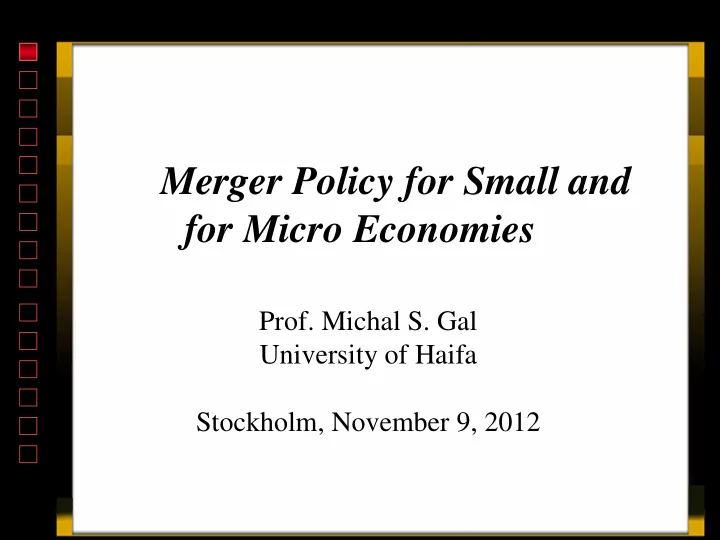

Merger Policy for Small and for Micro Economies Prof. Michal S. Gal University of Haifa Stockholm, November 9, 2012
Introduction Number growing Need a specially tailored merger law? Extreme case: Micro Jurisdictions Two forces of significance The Follower Push Unique Characteristics Pull Challenge similar: effective and efficient regime Change the content of the rule Mostly: increase its necessity
Definition: Small Economy Definition: independent sovereign jurisdiction that can support only a small number of competitors in most of its industries, when catering to demand. No magic number Three main factors: Population size Population dispersion Openness to trade
Basic Economic Characteristics High industrial concentration levels High entry barriers Minimum efficient scales Supply constraints Sub-Optimal Levels of Production Malta study : Interdependence Aggregate Concentration
General Implications Basic tension: Efficient scales of production Once created, market power difficult to erode Resource issue: Rules vs. Standards Implications: Balancing approach: long-term dynamic considerations; concentration necessary evil Illegality test to capture also coordinated act Credible threat limitations Michal S. Gal, Competition Policy for Small Market Economies (Harvard U. Press, 2003)
Aggregate Concentration The reality : A small group of economic entities control a large part of the economic activity through holdings in many markets Israel and Singapore: 16 hold 50% Hong Kong: 16 hold 84% The implications : Overcome entry barriers (Missing institutions) Reciprocal status quo Entry deterrence: stagnation and inefficiency Political economy implications Too big to fail
Merger Law solutions? The freestanding firm not always relevant unit for analysis, but rather the economic unit of which it is part of Practical: not “competition in a market” Wider lens, beyond portfolio effects Columbus Capital/Cur Industries Partial (tax, corporate, etc.)
Dynamic Analysis of Market Less emphasis on rigid structural variables Regional or International competition: Nippon Steel and Sumitomo Metal Industries NZ LET test: Likely, sufficient in Extent, and Timely South Pacific Seeds/Yates What is the time horizon? Concessions in the meantime?
Micro Economies Definition WTO: "small, vulnerable economies" with very low share of world merchandise trade A sovereign economy which (1) has a population of up to 200,000 and (2) is not economically immersed into a large jurisdiction (e.g. Andorra) Subgroup: miniscule economies with up to 50,000: regional solutions only 23 jurisdictions Mostly Caribbean and East Asia and the Pacific Mostly islands
Definition (2) mostly low-middle income Correlation: operational merger law and high income. Correlation: political dependency of a large jurisdiction Greenland, Guernsey, Jersey, Faroe Island, US Virgin Islands
Jurisdicti Populati GDP Island Competiti Merger Part of on on (US$)* on Law Law Regional 1 (2011 Agreement unless with merger otherwi law se indicate d) American 54,947 $575.3 yes no no no Samoa million (2007) Antigua 89,018 $1.595 yes no no in the and billion process of Barbuda developing a merger law Anguilla 15,423 $175.4 yes no no in the million process of (2009) developing a merger law Aruba 107,635 $2.258 yes no no no billion (2005) British 31,148 $853.4 yes no no in the Virgin million process of Islands (2004) developing a merger law Cook 10,777 $183.2 yes no no no Island million (2005)
Basic Economic Traits High entry barriers: High concentration to produce efficiently High transport costs from their major trading partners High costs of keeping stock Limited diversification Vulnerability to external shocks and natural disasters Many products produced elsewhere Significant diseconomies of scale in public services
Should mergers be regulated? Far from trivial; not dichotomic Question necessity of everything: procedural and substantive In favor market power, once created, is very difficult to erode some mergers have a very large impact on economy ( Ferryspeed/CHannel Express ) other competition law tools might be difficult to apply Cost effective? High "fixed" costs of merger review- especially in relative terms Often effects --in absolute financial terms -- would be minimal even a small regulatory burden (in absolute size) might limit incentives to enter into welfare-enhancing mergers many firms located elsewhere Bottom line: Carefully truncated review
Partial Institutional Solutions Regional competition law agreements OECS Channel Islands Competition Authority Regional Competition Law Agreements (Bakhoum et al. eds., Edgar Elgar, 2012). Combine regulatory functions Guernsey Technical Assistance
Substantive and Procedural Rules Very limited merger regulation What does not change? Limiting application to domestic firms List potentially harmful industries? Narrow thresholds that change in some markets Domestic thresholds that capture absolute harm Limiting application to foreign firms 88% between firms in developed jurisdictions. Credible threat List? Corridor notification; but can impose local remedies Conditional remedies
Conclu Conclusion sion Size affects merger law Sometimes- change content Mostly- similar, but more costly not to follow The smaller the jurisdiction, the more severe the effects Follower Push will be justified in many cases, but not in all
Thank you! mgalresearch@gmail.com http://papers.ssrn.com
Recommend
More recommend